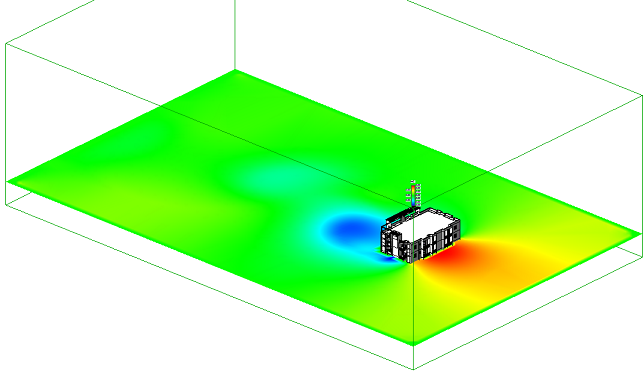You are here
Besides considerations of thermal comfort, indoor air quality means that the chemical composition of indoor air is clean and fresh. This means avoiding chemical pollutants, particulates, pollen, mold and mildew, pathogens, and other unwanted substances in the air, as well as bringing in new air at an adequate rate.
Several government and non-governmental organizations in America have established indoor air quality standards, such as the American Society of Heating, Refrigerating and Air- Conditioning Engineers standard ASHRAE 189.1, the Sheet Metal and Air Conditioning Contractors' National Association's SMACNA IAQ Guidelines, and the South Coast Air Quality Management District's SCAQMD Rules.
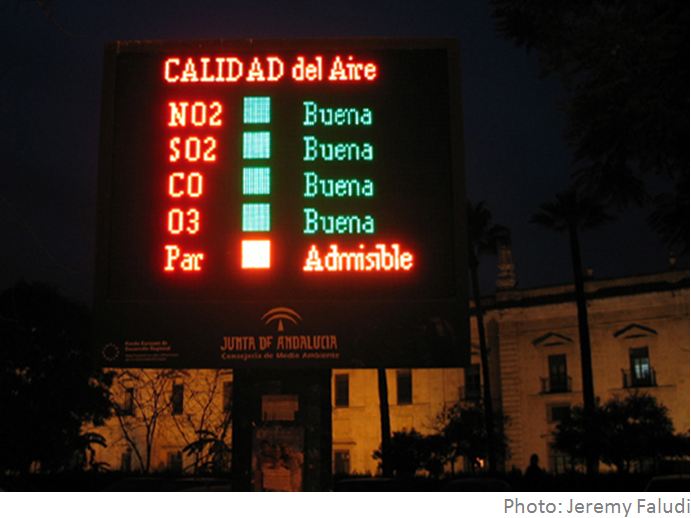
Some cities monitor and report on outdoor air quality in real-time.
Fresh Air
As people breathe in oxygen and breathe out CO2, air becomes "stale"; when CO2 concentrations are too high, occupants become tired, less happy, and have difficulty concentrating. Bringing in fresh outside air with plenty of oxygen keeps people happier, more energetic, and more alert. The LEED rating system has credits for both meeting and exceeding ASHRAE standards for fresh air.
How much outside air is enough? It depends on the program of the room. ASHRAE 62.1 Table 6.1 has a long list of minimum outdoor air requirements for different types of room, from offices to gymnasiums to bank vaults. A small sample is below.
|
Building / Room Type |
Minimum |
|
| Office | 5 | 2.5 |
| Classroom | 10 | 5 |
| Bedroom | 5 | 2.5 |
| Laboratory | 10 | 5 |
| Multi-Use Assembly | 7.5 | 3.8 |
Sample of minimum outdoor air requirements for different programs
Many architects and engineers hold themselves to more stringent standards than these, with much higher rates of outdoor air--sometimes double or triple.1 The more fresh air people have, the more awake and alert and happy they are, though increasing outdoor air eventually has diminishing returns.
Using more outside air usually increases a building's energy use because that air is usually circulated, heated, or cooled. But you can save energy with good passive ventilation and efficient HVAC design techniques like energy recovery ventilation.
Clean Air
Impurities in air can be avoided by eliminating the sources of impurities, flushing out spaces with clean air, and by filtering the air to remove impurities.
Filtering generally increases the energy use of HVAC systems by increasing the resistance to air flow, but filters with larger surface area can be chosen to reduce resistance. Flushing out spaces with clean air is generally done between construction and occupancy.
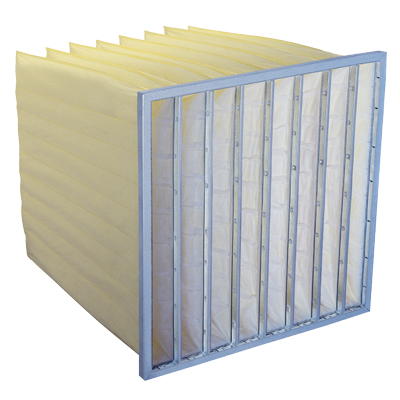
Tight filters have large surface areas to avoid causing too much resistance to ventilation systems.
Eliminating impurity sources is generally done by four methods:
- Avoiding mold and mildew by avoiding condensation in building materials and HVAC systems
- Installing floor grates to avoid dirt being tracked into the building
- Banning smoking in the building and near HVAC air inlets
- Choosing interior finish materials that do not offgas volatile organic compounds (VOC's)
Both the LEED rating system and the Living Building Challenge have credits for three out of four of these strategies.
Avoiding Mold
Mold and mildew are extremely common indoor air pollutants, especially in humid climates. The simplest way to avoid them in the building envelope is to avoid condensation. To avoid condensation in the envelope, the best techniques are to let the building envelope breathe (so that moisture occurring in the envelope can escape), or to have the envelope's dewpoint occur in the middle of a solid material, such as closed-cell spray foam (so there’s no moisture present to condense).
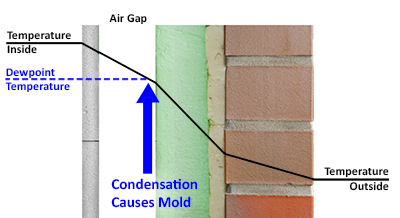
When the dewpoint falls within an air gap in the building envelope, condensation will form on surfaces,
encouraging mold unless it can evaporate away.
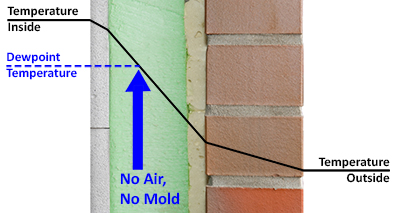
When the dewpoint falls within a sealed material like closed-cell foam, there is no condensation to grow mold.
Many building operation measures can help prevent mold growth, as well. Some recommendations from the US EPA and US CDC are these:
- Design the building envelope to avoid condensation within walls and other constructions.
- Vent showers and other moisture-generating sources to the outside.
- Control humidity levels and dampness by using air conditioners and de-humidifiers.
- Provide adequate ventilation to maintain indoor humidity levels between 30-60%.
- Use exhaust fans whenever cooking, dishwashing, and cleaning in food service areas.
- Clean and dry any damp or wet building materials and furnishings within 24-48 hours of occurrence to prevent mold growth.
Materials For Clean Air
Certain types of materials and finishes are very prone to emitting volatile organic compounds (VOCs) and other pollutants.
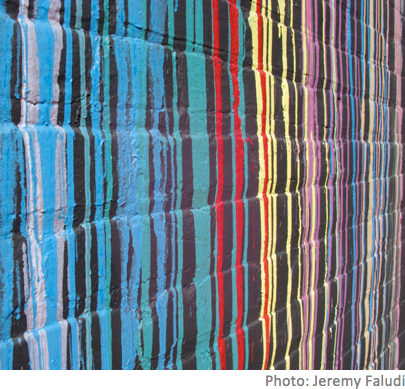
Choosing low VOC paint can keep indoor air quality high.
Volatile organic compounds release molecules to the surrounding air that can be harmful to human health and/or the environment. VOCs are measured by the grams per liter of the substance that escape to the outside air (g/L).
Building products that typically contain VOCs are carpets, paints and other finish coatings, sealants, adhesives, and products that use adhesives extensively, such as furniture and other composite wood products.
| Architectural Applications | Current VOC Limit (g/L) |
| Indoor Carpet Adhesives | 50 |
| Carpet Pad Adhesives | 50 |
| Outdoor Carpet Adhesives | 150 |
| Wood Flooring Adhesive | 100 |
| Rubber Floor Adhesives | 60 |
| Subfloor Adhesives | 50 |
| Ceramic Tile Adhesives | 65 |
| VCT and Asphalt Tile Adhesives | 50 |
| Dry Wall and Panel Adhesives | 50 |
| Cove Base Adhesives | 50 |
| Multipurpose Construction Adhesives | 70 |
| Structural Glazing Adhesives | 100 |
| Single Ply Roof Membrane Adhesives | 250 |
A summary of the SCAQMD rules for low-VOC adhesives.
The In the United States, the SCAQMD rules for stains, primers, and other finishes is another commonly-referenced standard, as is the Green Seal standard for paints and coatings, which allows 50 to 300 grams of VOCs per liter of paint.
Certification systems such as LEED also give credits for composite wood whose adhesives do not contain any added urea formaldehyde resins. (Phenol formaldehyde resins are generally considered safe.)
The field of environmental toxicology is still young, and guidelines for building materials are evolving. In addition to the restrictions above, the Living Building Challenge also includes a "red list" of materials that cause human health problems and should not be used. These include halogenated flame retardants, PVC, Neoprene, and wood treatments with creosote, arsenic or pentachlorophenol.
Controls
Some advanced building information management systems adjust the rates of incoming outdoor air to keep indoor air fresh enough and clean enough without using too much energy.
These control systems use CO2 sensors to test the freshness of air; especially advanced ones even use pollutant sensors (particulates, VOCs, or others) to measure air cleanliness. Such systems can help conserve energy by only running ventilation systems when necessary for occupant health and happiness. These may include Demand-Controlled Ventilation (DCV) or Supply Air CO2 Control(SACO2).

Carbon monoxide, carbon dioxide, and volatile organic compound sensors at the Pacific Energy Center.
1 See G.Z. Brown, Sun, Wind, and Light: architectural design strategies (2nd. Ed., 2001), p.237.
| Attachment | Size |
|---|---|
| 56.93 KB |

